ATI Radeon HD 3870 & 3850: A Return to Competition
by Anand Lal Shimpi & Derek Wilson on November 15, 2007 12:00 AM EST- Posted in
- GPUs
Let's Get It Out of the Way: Radeon HD 3870 vs. GeForce 8800 GT
The question on everyone's mind is how well does the 3870 stack up to the recently launched GeForce 8800 GT? If you haven't been noticing our hints throughout the review, AMD doesn't win this one, but since the 3870 is supposed to be cheaper a performance disadvantage is fine so long as it is justified by the price.
Does the 3870 deliver competitive performance given its price point? Let's find out.
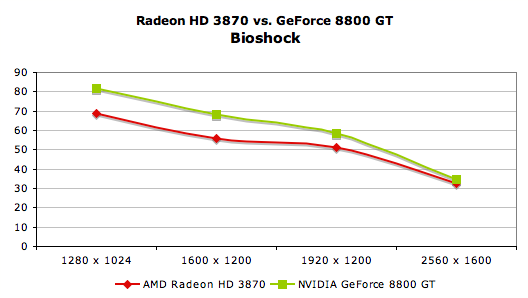
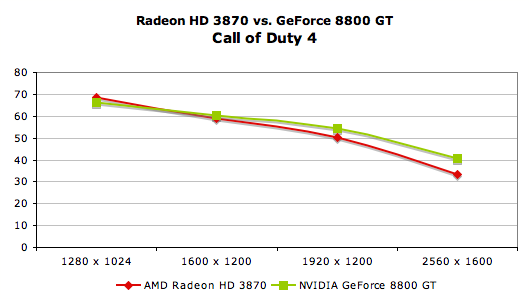
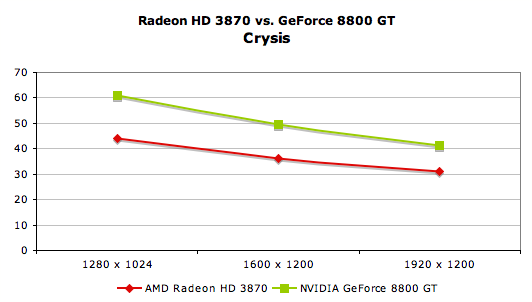

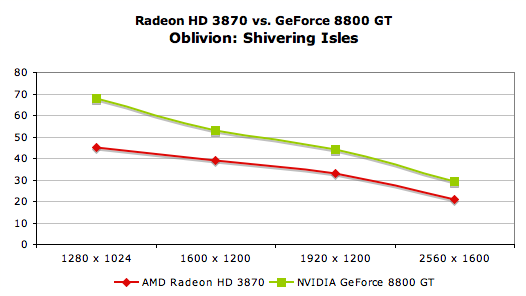
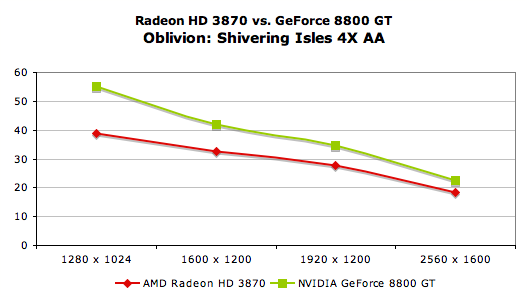
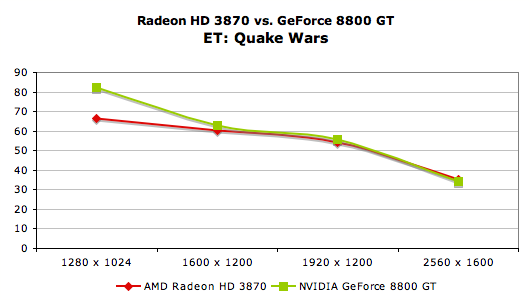
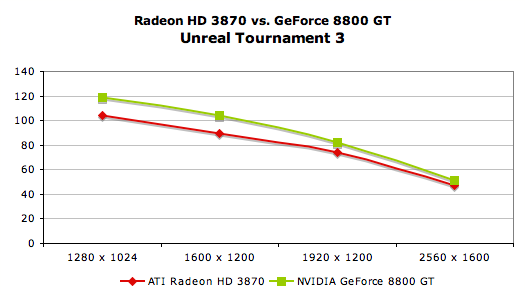
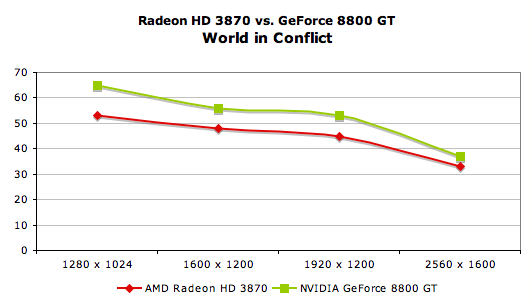
Honestly, the Radeon HD 3870 stays very close to the 8800 GT, much closer than AMD's previous attempts to touch the 8800 series. But is the price low enough to justify the performance difference? For that we must do a little numerical analysis; the table below shows you what percentage of the 8800 GT's performance the Radeon HD 3870 delivers:
| 3870: % of GeForce 8800 GT Performance | 1280 x 1024 | 1600 x 1200 | 1920 x 1200 | 2560 x 1600 |
| Bioshock | 84.4% | 82.4% | 87.9% | 93.9% |
| Unreal Tournament 3 | 87.8% | 85.8% | 89.6% | 91.6% |
| ET: Quake Wars | 80.5% | 95.9% | 96.8% | 103% |
| Oblivion | 66.7% | 74.1% | 74.4% | 71.5% |
| Oblivion (4X AA) | 70.5% | 77.7% | 80.2% | 82.6% |
| Half Life 2: Episode 2 | 101% | 95% | 91% | 86.7% |
| World in Conflict | 81.5% | 85.7% | 84.9% | 89.2% |
| Call of Duty 4 | 103% | 98.3% | 92.3% | 82.1% |
| Crysis | 72.4% | 73.3% | 75.5% | - |
| Average | 83.1% | 85.3% | 85.8% | 87.6% |
Here's what's really interesting, on average the Radeon HD 3870 offers around 85% of the performance of the 8800 GT, and if we assume that you can purchase an 8800 GT 512MB at $250, the 3870 manages to do so at 87% of the price of the 8800 GT. The Radeon HD 3870 becomes even more attractive the more expensive the 8800 GT is and the opposite is true the cheaper it gets; if the 8800 GT 512MB was available at $219, then the 3870 doesn't stand a chance.
If AMD can actually meet its price expectations then it looks like the 3870 is actually competitive. It's slower than the 8800 GT, but the price compensates.










117 Comments
View All Comments
Locut0s - Thursday, November 15, 2007 - link
1) Only Vista was used, though XP has a lot larger user base.You answered your own question there. Remember this card is aimed at the midrange not the enthusiast and even more of these consumers are using XP.
2) Limited variety of games.
The games covered though are all the important big names that actually stress these cards and show what they are made of.
3) Limited variation of AF/AA
See Anand's reply above
4) No UVD tests.
You can see previous reviews to see UVD performance. I doubt this has changed at all since the hardware is identical.
NullSubroutine - Thursday, November 15, 2007 - link
I was saying XP should have been benchmarked because it is the largest userbase and most people especially at this price range will be using XP.When you limit the number of games benchmark you do not show an accurate performance of a video card, it has been shown that certain games play better on certain cards. Some sites only do reviews with games that are biased towards a certain brand or GPU; I expect that Anandtech is not one of those sites and expect a variety of games that show the true performance of the cards.
Locut0s - Thursday, November 15, 2007 - link
Sorry misread your question about XP/Vista. Yes they could test on XP. However it has been shown that the performance difference between the two is fairly small now and is in XPs favour meaning that games should run as good or better than what they show here.NullSubroutine - Thursday, November 15, 2007 - link
I would have to disagree. There was at least a 20 to 25 percent difference in XP very high settings vs Visa very high settings in Crysis. If you look at any number of games, there is still a deficit for performance betwen XP and Vista, while the gap is shrinking, it is still very pronounced.Anand Lal Shimpi - Thursday, November 15, 2007 - link
I think the real solution to the XP/Vista issue is to do a separate article looking at driver performance in XP vs. Vista. Derek was working on such a beast before the 8800 GT launched, and as far as I remember he found that with the latest driver releases that there's finally performance parity between the OSes (and between 32-bit/64-bit versions of Vista as well, interestingly enough).As far as more titles go, we tried to focus on the big game releases that people were more likely upgrading their hardware for. Time is always limited with these things, but do you have any specific requests for games you'd like to see included? As long as they aren't overly CPU limited we can always look at including them.
I'll have to confirm with Derek, but I believe UVD performance hasn't changed since our last look at UVD with these GPUs: http://www.anandtech.com/showdoc.aspx?i=3047">http://www.anandtech.com/showdoc.aspx?i=3047.
Thanks for the suggestions, I aim to please so keep it coming :)
Take care,
Anand
NullSubroutine - Friday, November 16, 2007 - link
The biggest discreptency (spelling) I have seen between all reviews have been the drivers used (especially if you take in consideration the difference from say XP to Vista 64 bit new to old drivers).Many review sites are using drivers that came with the disks, 8.43 or 8.44 which are supposed to be out Nov 15th for download (I couldnt find them on AMD's site earlier today). There seems to be these new drivers (must be beta drivers) give a huge boost in performance (it seems) for the 3800 series.
What I cannot figure out why they test the 3800 series with the 8.43/8.44 but the 2900s with 7.10. So its hard to tell if the newer drivers are good for the HD series in general or more specific to the 3800s.
Has Anand tested the different drivers?
Lonyo - Thursday, November 15, 2007 - link
They can't really test in XP that easily.Either they test in Vista, or they test in Vista AND XP (to be able to run DX10 benchmarks).
I expect it's just easier to do all the tests in one OS, rather than having half run in Windows XP, except for DX10 which they run in Vista.
MGSsancho - Thursday, November 15, 2007 - link
I agree with you on that. I think there will be another UVD article later. like nothing but what video cards can offload parts of the video decode, what minimial cpu is needed for like a HTPC to run HD movies.Xp would be cool.
but Anand, could you do a 32b v 64b? i know you mentioned it in the article, but can you do 1gb, 2gb, 4gb, and 8gb configs? maybe current games with single core (AMD 57FX the old king), with a dual core then a quad core? i bring up 8gb for a reason. now aday we can get 2gb dimms. And some of us us our comps for other task like running a few virtual mahchines minimized. we minimize our work, game for a 30 min break then go back to work. or maybe were running apache for a home website. or many other task that simply eat up ram (leaving FF open for weeks}.
Im not asking for a dual socket god machine. but with current mobos, its possible to do 8gb of ram. thanks for reading this and take care.
Locut0s - Thursday, November 15, 2007 - link
With all the buzz in the CPU world nowadays being about more cores and not more MHZ it's interesting to see that the latest graphics cards have been all about more MHZ and more features. It seems to me that it's in the graphics card world that more cores would make the most sense given the almost infinite scalability of rendering. Instead of making the next generation of GPUs more and more complex than the previous generation why not work instead on making these GPUs work together better. Then your next generation card could just be 4 or 5 of the current generation GPUs on the same die or card. Think of it, if they can get the scaling and drivers down pat then you could churn out blazingly fast cards just by adding more cores to the card. And as long as you are manufacturing the same generation chip and doing so at HUGE volumes the cost per chip should go down too.Think this is something we will start to see soon?
Gholam - Thursday, November 15, 2007 - link
In case you haven't noticed, graphics cards have been packing cores by the dozens from the beginning - and lately, by the hundreds.